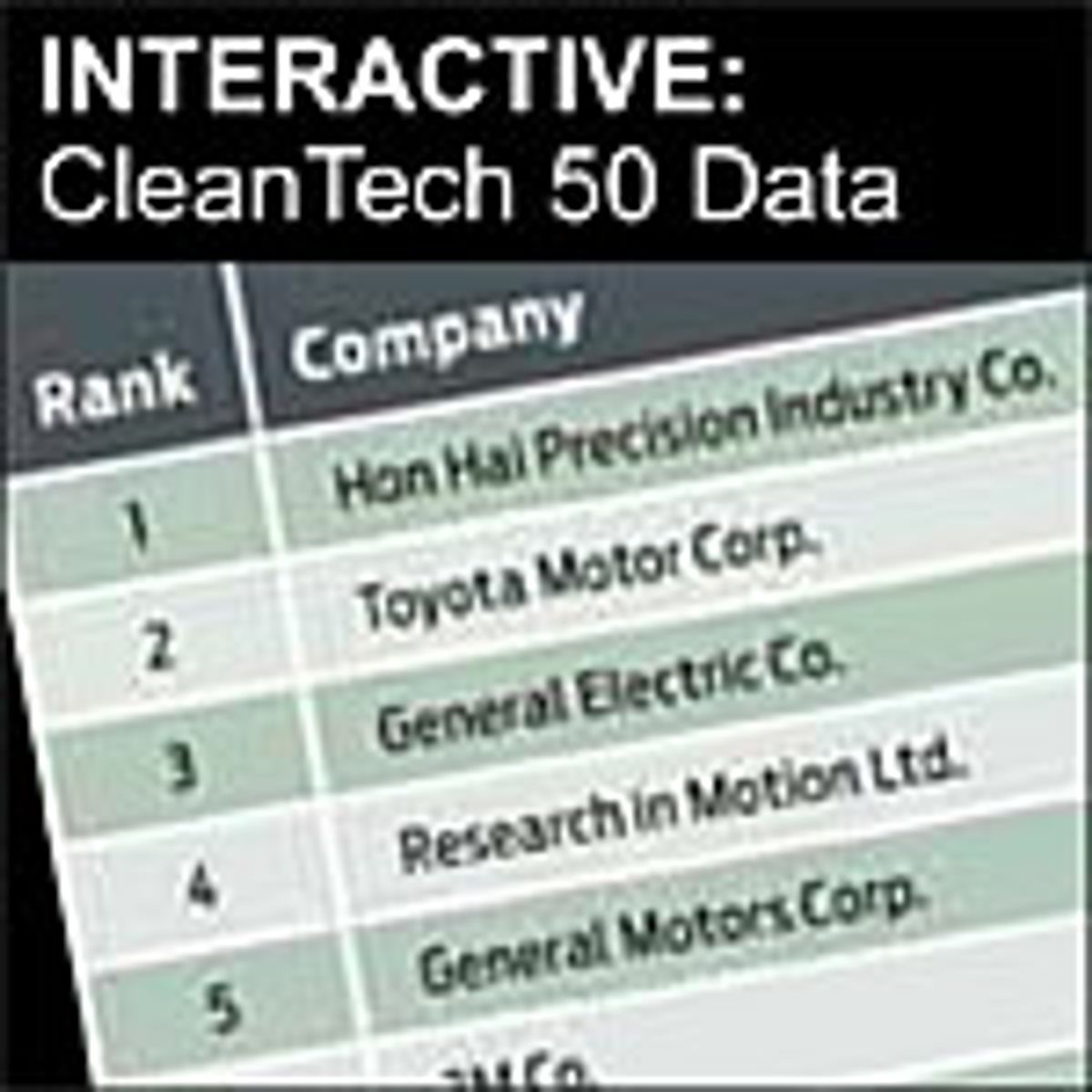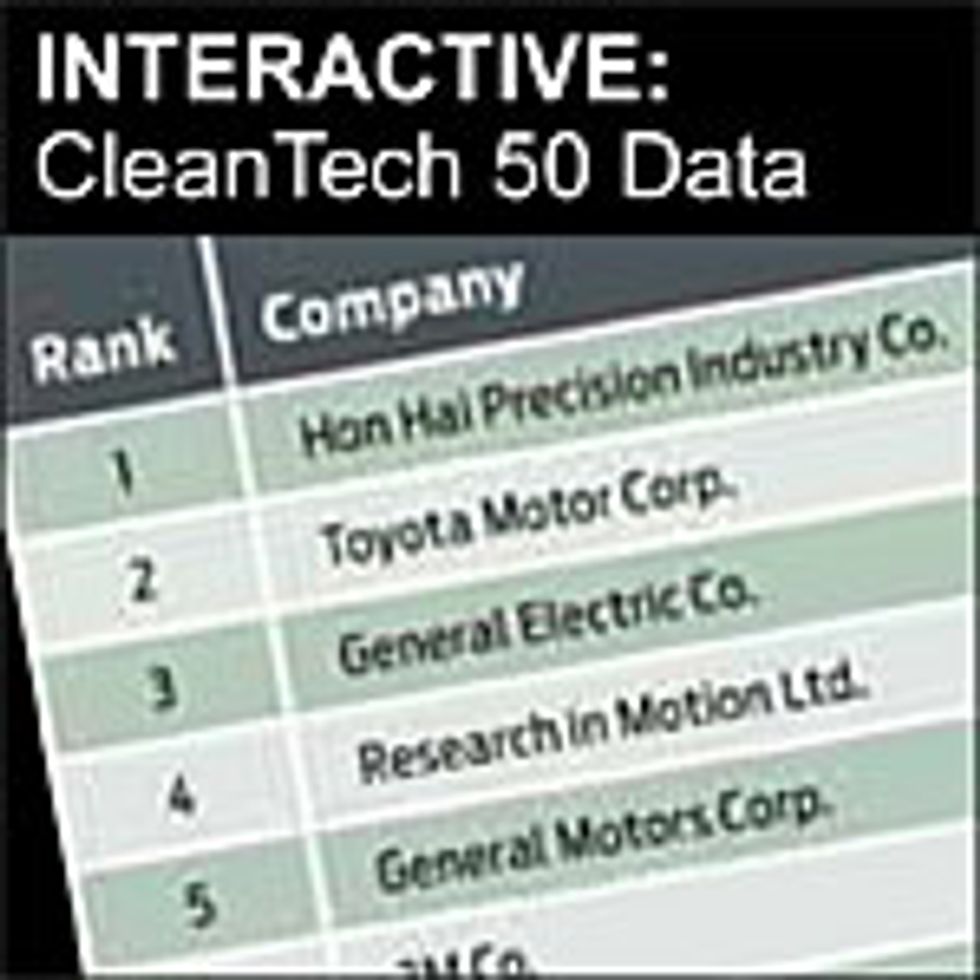The Clean Tech 50
IEEE Spectrum and 1790 Analytics rank the 50 top clean tech patent portfolios

"The nation that leads the clean energy economy will be the nation that leads the global economy," President Obama proclaimed in his 2010 State of the Union address. Worldwide, investors are already buying into this vision. In 2009, the U.S. investment totaled US $18.6 billion in renewable energy projects, according to estimates from Bloomberg New Energy Finance. That’s an impressive figure, but one that’s still dwarfed by the $34.6 billion spent in China.
Considering the big role that innovations in clean technology will play in our future, we present here the first Clean Tech 50—a scorecard containing the 50 organizations with the world’s most powerful clean technology patent portfolios of 2009. To rank them, we used the same techniques and metrics that we did for creating IEEE Spectrum’s annual Patent Power scorecards (see Patent Power, IEEE Spectrum, November 2006) but with one key difference: While the Patent Power scorecards weigh every U.S. patent in an organization’s portfolio, for the Clean Tech 50 we consider only patents with applications for clean technologies.
Naturally, this prompts the question: What qualifies as clean technology? After scouring Spectrum’s news archives for the most talked-about technologies with potential for generating power without polluting the environment, we selected eight candidates: batteries, clean coal, fuel cells, geothermal energy, hybrid vehicles, hydropower, solar energy, and wind energy.
To create the Clean Tech 50, we then searched, using keywords and patent classifications, for patents in the United States Patent and Trademark Office database that could serve as building blocks for engineering new technologies in at least one of these categories. A patent qualified as a clean technology patent if it either specifically referenced a clean technology application or was classified by the U.S. Patent Office in direct relation to one. Using this somewhat conservative approach meant that some deserving patents were omitted. For example, a patent describing a new power conversion technique may have been filed with coal plants in mind. But the technique might also be useful for connecting wind turbines to the grid. Still, there are many more patents for power-conversion technologies that have little relevance to clean energy, and including them would have significantly distorted our calculations.
From the final list, a number of interesting themes emerge. Consider, for instance, the geographical distribution of organizations. Of the 50 that made the list, 24 are based in Asia and 22 are based in the United States. Of the four remaining, three are European and one is Canadian. By comparison, of the 1000 leading organizations in the U.S. patent system, slightly more than half are based in the United States, roughly a quarter in Asia, and a fifth in Europe. This means there are almost twice as many Asian organizations in the Clean Tech 50 as one would expect, including five of the top ten: Hon Hai Precision, Toyota, Samsung, Honda, and Casio. This reflects Asia’s extensive investment in clean technologies. At the same time, the United States has about as many organizations in the Clean Tech 50 as expected, while Europe is significantly underrepresented.
The Clean Tech 50 also provides some industry insights. For example, there are six auto manufacturers ranked among the top 20 organizations. This is not surprising, given automakers’ focus on finding alternatives to traditional gasoline engines. What’s interesting is that they seem to be pursuing very different approaches to achieving this goal.
Toyota, the leading automaker in the Clean Tech 50, has patents in the three clean technologies most relevant to the auto industry: batteries, fuel cells, and hybrid vehicles. The same is true of Japanese parts manufacturer Denso, though the company has fewer patents in each category. General Motors, on the other hand, owns patents primarily in just two categories: fuel cells and hybrid vehicles. Similarly, Nissan appears to be pursuing mainly fuel cells and batteries. The remaining two high-ranking automakers on the Clean Tech 50 have narrowed their focus to only one technology: fuel cells for Honda and hybrid vehicles for Ford.
Electronics companies also have a strong presence at the head of the Clean Tech 50. The big innovators of battery technology—Hon Hai Precision, Research in Motion, and Samsung—lead the ranks. Samsung’s profile, in particular, is worth paying attention to. Moving beyond battery technology, the company has also developed a robust fuel cell portfolio. Though unusual for the electronics industry, Samsung’s innovations in fuel cell research were no doubt inspired by its efforts to develop cellphones and laptops powered by fuel cells.
Scanning the Clean Tech 50 data set, you can also get a sense of how dedicated a company is to clean technologies over other innovations. Take a look at Hon Hai Precision. With a Pipeline Power score of 314.17, the Chinese electronics giant ranks No. 1 in the Clean Tech 50. Yet clean technology patents account for less than 1 percent of all its 2009 patents. Other large companies leading the Clean Tech 50, notably General Electric, Research in Motion, and 3M, also have patent portfolios with just a small percentage devoted to clean technology.
Now check out Quallion. The small California company, which designs and manufactures lithium-ion batteries, has a patent portfolio that’s 89 percent clean. Similarly, Nanosolar, another California company, which makes printable solar cells, has devoted 60 percent of its innovations to clean technology, while the Indian wind power company Suzlon has devoted a full 100 percent. These companies may have far fewer patents than larger companies in the Clean Tech 50, but they still achieve top rankings, because their patents are of high quality. In fact, the patent portfolios of small clean technology companies tend to have remarkably high impacts on innovation given their size disadvantage, according to a recent study that our company, 1790 Analytics, conducted for the Small Business Administration. This goes to show that it pays to look beyond simple patent counts in order to spotlight the organizations that are leading the world to a clean energy economy.
The complete data tables for this report are available here in PDF format for download.
About the Author
Patrick Thomas and Anthony Breitzman are cofounders of 1790 Analytics. The firm specializes in technology analysis and intellectual property evaluation for large corporations, government agencies, and financial institutions.
Interactive graphics by Information Design Studio.
